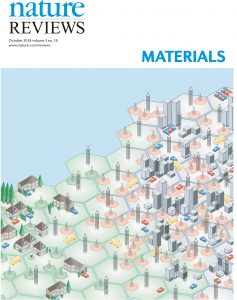Graphene enables ultra-wide bandwidth communications coupled with low power consumption, with potential to surpass the needs of 5G, IoT and Industry 4.0.
Researchers within the Graphene Flagship project, one of the biggest research initiatives of the European Commission, showed that integrated graphene-based photonic devices offer a unique solution for the next generation of optical communications.

Researchers in the initiative have demonstrated how properties of graphene enable ultra-wide bandwidth communications coupled with low power consumption to radically change the way data is transmitted across the optical communications systems. This could make graphene-integrated devices the key ingredient in the evolution of 5G, the Internet-of-Things (IoT), and Industry 4.0. The findings were published in Nature Reviews Materials and highlighted on the cover.
“As conventional semiconductor technologies are approaching their physical limitations we need to explore entirely new technologies to realise our most ambitious visions of a future networked global society,” explains Wolfgang Templ, Department Head of Transceiver Research at Nokia Bell Labs in Germany, which is a Graphene Flagship partner. “Graphene promises a significant step in performance of key components for optical and radio communications beyond the performance limits of today’s conventional semiconductor-based component technologies.”
Daniel Neumaier from AMO GmbH and also leader of the Graphene Flagship Division on Electronics and Photonics Integration, adds: “Optical communication links will become more and more important in 5G for supporting the required high data rates at all nodes. Graphene based optical components integrated on a silicon platform will be able to deliver both increased performance and a low-cost production process, thus are expected to become key components in the 5G era.”
 The Graphene Flagship presents a vision for the future of graphene-based integrated photonics, and provides strategies for improving power consumption, manufacturability and wafer-scale integration. With this new publication, the Graphene Flagship partners also provide a roadmap for graphene-based photonics devices surpassing the technological requirement for the evolution of datacom and telecom markets driven by 5G, IoT, and the Industry 4.0. “Graphene integrated in a photonic circuit is a low cost, scalable technology that can operate fibre links at a very high data rates,” said Marco Romagnoli, from Graphene Flagship partner CNIT, the National Interuniversity Consortium for Telecommunications in Italy.
The Graphene Flagship presents a vision for the future of graphene-based integrated photonics, and provides strategies for improving power consumption, manufacturability and wafer-scale integration. With this new publication, the Graphene Flagship partners also provide a roadmap for graphene-based photonics devices surpassing the technological requirement for the evolution of datacom and telecom markets driven by 5G, IoT, and the Industry 4.0. “Graphene integrated in a photonic circuit is a low cost, scalable technology that can operate fibre links at a very high data rates,” said Marco Romagnoli, from Graphene Flagship partner CNIT, the National Interuniversity Consortium for Telecommunications in Italy.
This industrial and academic partnership, comprising companies and research centres in five different European countries, has developed a compelling vision for the future of graphene photonic integration. The team involves researchers from CNIT, Ericsson, IMEC, Nokia, Nokia Bell Labs, AMO, ICFO and the University of Cambridge. These collaborations are at the heart of the Graphene Flagship, set up by the European Commission to support the commercialisation of graphene and related materials until 2023. “The Graphene Flagship is a unique ecosystem in which industrial and academic partners work together for a longer period than a normal EU project. This synergy over an enduring term produces unprecedented results both in science and innovation,” comments Romagnoli.
“Collaboration between industry and academia is key for explorative work towards entirely new component technology. Research in this phase bears significant risks, so it is important that academic research and industry research labs join the brightest minds to solve the fundamental problems. Industry can give perspective on the relevant research questions for potential in future systems,” adds Templ of Nokia Bell Labs. “Thanks to a mutual exchange of information we can then mature the technology and consider all the requirements for a future industrialization and mass production of graphene-based components.”
Graphene photonics offers advantages in both performance and manufacturing over the state of the art. Graphene can ensure modulation, detection and switching performances meeting all the requirements for the next evolution in photonic device manufacturing. “We aim for highly integrated optical transceivers which will enable ultra-high bitrates well beyond one terabit per second per optical channel. These targeted systems will differentiate from their semiconductor-based forerunners by substantially lower complexity, energy dissipation and form factor going along with a higher flexibility and tunability,” explains Templ.
Reference:
“Graphene-based integrated photonics for next-generation datacom and telecom.” M. Romagnoli, V. Sorianello, M. Midrio, F. H. L. Koppens, C. Huyghebaert, D. Neumaier, P. Galli, W. Templ, A. D’Errico, A. C. Ferrari. Nature Reviews Materials, 3, 392-414 (2018). DOI: 10.1038/s41578-018-0040-9.
Contact information:
Dr. Fernando Gomollón-Bel Graphene Flagship Press and Communications Coordinator Phone: +44 1223 762391 Mobile: +34 676 193899 Email: press@graphene-flagship.eu Web: www.graphene-flagship.eu
Follow the Graphene Flagship on Twitter, Facebook, LinkedIn, Instagram and Youtube
Official Graphene Flagship Press Release:
